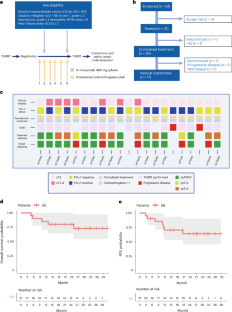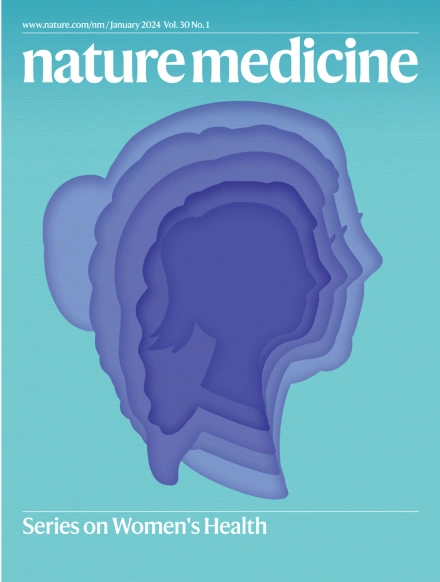Oncolytic immunotherapy with nivolumab in muscle-invasive bladder cancer: a phase 1b trial
IF 58.7
1区 医学
Q1 BIOCHEMISTRY & MOLECULAR BIOLOGY
引用次数: 0
Abstract
There is a critical unmet need for safe and efficacious neoadjuvant treatment for cisplatin-ineligible patients with muscle-invasive bladder cancer. Here we launched a phase 1b study using the combination of intravesical cretostimogene grenadenorepvec (oncolytic serotype 5 adenovirus encoding granulocyte–macrophage colony-stimulating factor) with systemic nivolumab in cisplatin-ineligible patients with cT2-4aN0-1M0 muscle-invasive bladder cancer. The primary objective was to measure safety, and the secondary objective was to assess the anti-tumor efficacy as measured by pathologic complete response along with 1-year recurrence-free survival. No dose-limiting toxicity was encountered in 21 patients enrolled and treated. Combination treatment achieved a pathologic complete response rate of 42.1% and a 1-year recurrence-free survival rate of 70.4%. Pathologic response was associated with baseline free E2F activity and tumor mutational burden but not PD-L1 status. Although T cell infiltration was broadly induced after intravesical oncolytic immunotherapy, the formation, enlargement and maturation of tertiary lymphoid structures was specifically associated with complete response, supporting the importance of coordinated humoral and cellular immune responses. Together, these results highlight the potential of this combination regimen to enhance therapeutic efficacy in cisplatin-ineligible patients with muscle-invasive bladder cancer, warranting additional study as a neoadjuvant therapeutic option. ClinicalTrials.gov identifier: NCT04610671 . In a phase 1b trial, treatment of patients with muscle-invasive bladder cancer with intravesical oncolytic virus cretostimogene grenadenorepvec in combination with nivolumab was safe and led to encouraging preliminary clinical response rates.


使用 nivolumab 的溶瘤免疫疗法治疗肌肉浸润性膀胱癌:1b 期试验
对于不符合顺铂治疗条件的肌层浸润性膀胱癌患者来说,安全有效的新辅助治疗是一项亟待解决的问题。在此,我们启动了一项1b期研究,在不符合顺铂治疗条件的cT2-4aN0-1M0肌层浸润性膀胱癌患者中,采用膀胱内注射克雷莫司汀-格雷纳多雷韦克(编码粒细胞-巨噬细胞集落刺激因子的5型溶瘤血清型腺病毒)与全身用尼伐单抗联合治疗。该研究的首要目标是衡量安全性,次要目标是评估抗肿瘤疗效(以病理完全反应和1年无复发生存率来衡量)。入组并接受治疗的 21 名患者均未出现剂量限制性毒性。联合治疗的病理完全反应率为 42.1%,1 年无复发生存率为 70.4%。病理反应与基线游离 E2F 活性和肿瘤突变负荷有关,但与 PD-L1 状态无关。虽然膀胱内溶瘤免疫疗法广泛诱导了T细胞浸润,但三级淋巴结构的形成、增大和成熟与完全应答特别相关,支持了体液和细胞免疫应答协调的重要性。总之,这些结果凸显了这种联合疗法在提高不符合顺铂治疗条件的肌层浸润性膀胱癌患者疗效方面的潜力,值得作为新辅助治疗方案进行更多研究。ClinicalTrials.gov 标识符:NCT04610671:NCT04610671。
本文章由计算机程序翻译,如有差异,请以英文原文为准。
求助全文
约1分钟内获得全文
求助全文
来源期刊

Nature Medicine
医学-生化与分子生物学
CiteScore
100.90
自引率
0.70%
发文量
525
审稿时长
1 months
期刊介绍:
Nature Medicine is a monthly journal publishing original peer-reviewed research in all areas of medicine. The publication focuses on originality, timeliness, interdisciplinary interest, and the impact on improving human health. In addition to research articles, Nature Medicine also publishes commissioned content such as News, Reviews, and Perspectives. This content aims to provide context for the latest advances in translational and clinical research, reaching a wide audience of M.D. and Ph.D. readers. All editorial decisions for the journal are made by a team of full-time professional editors.
Nature Medicine consider all types of clinical research, including:
-Case-reports and small case series
-Clinical trials, whether phase 1, 2, 3 or 4
-Observational studies
-Meta-analyses
-Biomarker studies
-Public and global health studies
Nature Medicine is also committed to facilitating communication between translational and clinical researchers. As such, we consider “hybrid” studies with preclinical and translational findings reported alongside data from clinical studies.
 求助内容:
求助内容: 应助结果提醒方式:
应助结果提醒方式:


